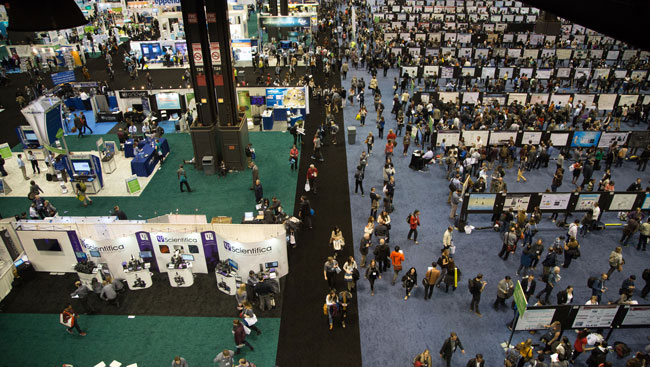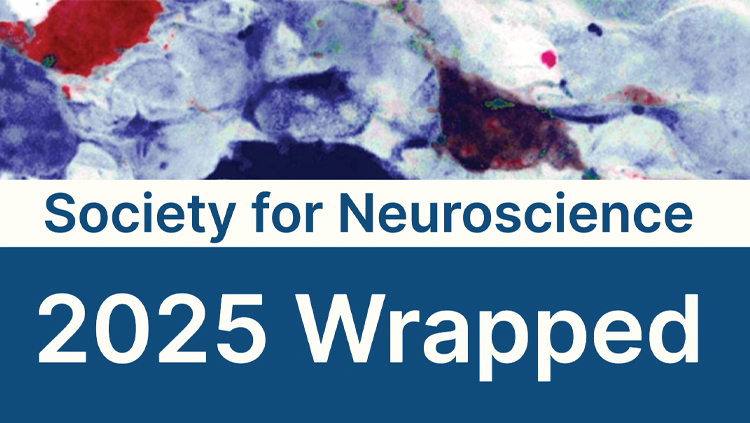Are you planning on attending SfN's annual meeting? Whether you’ll be presenting a poster, networking with potential collaborators, or looking for your next job, SfN’s annual meeting can provide you with an unparalleled opportunity to learn and connect with the neuroscience community.
However, to have a successful meeting, it’s important to plan your itinerary carefully. Familiarize yourself with the poster themes before you arrive, and know the difference between posters and symposia, minisymposia, and nanosymposia. You can also make a schedule of the events you want to attend and their location in advance of the meeting, using the Neuroscience Meeting Planner (NMP) and the mobile app.
As you plan your time, keep your reason for attending in mind to help you shape your schedule. Select yours from the list below and click to reveal specific tips.
Presenting Your Research
- Think carefully about how you design your poster and organize your talk. Talk to your mentor about the best approach for your research, especially if you are also presenting your research via the virtual platform.
- Expand the reach of your abstract by uploading a virtual poster in addition to presenting in person. All abstract presenters have the option to upload a virtual poster that will be available for 30 days after the meeting ends.
- Prepare a 30-second overview of your poster. When a visitor approaches, begin with the brief overview — don’t launch into a full explanation of your project. Following your overview, let visitors tell you what they are interested in hearing more about, and consider asking visitors how much time they have and the level of detail they’re looking for.
- Locate the site of your poster presentation before your presentation date. As your schedule allows, attend poster sessions in advance of your presentation to learn from what others are doing.
- Pick up a “Poster Presenter” ribbon at one of the kiosks located on the poster floor.
- Split your time during your poster session between standing at your poster and speaking with other presenters about their posters. Don’t forget, you must stand at your poster during your assigned one required hour.
- Leave business cards and a printout with information on your project (after you verify you can with your funding agency and PI) when not at your poster.
- Invite colleagues and friends to attend your poster. You will build confidence by practicing your talk with familiar people. Also, poster session attendees are drawn to a crowd, so this tactic may increase the number of attendees who drop by.
Learning About Research in Your Area of Study
- Consider attending a preconference workshop. On the Friday before the meeting, SfN will offer a scientific short course focused on ethics, rigor, and responsible conduct of research.
- Attend clinical training opportunities such as a Basic-Translational-Clinical Roundtable or Meet-the-Clinician-Expert session.
- Prepare to attend posters by reading presenters’ papers and identifying the methods and results you want to discuss.
- Ask poster presenters to walk you through their presentation. After each poster, immediately write notes. Consider including the unique poster number alongside your notes so you can look up the presenters’ abstracts after the meeting in the NMP or mobile app.
- Split your time between posters, symposia, minisymposia, and nanosymposia.
- Bring business cards with your current email address and update your information in the virtual contact card in the mobile app.
- Ask for business cards when you meet new people or share virtual contact cards via the mobile app. Write notes about your discussion topics and why you want to connect with them on the back of their cards or in your notes.
- Visit the NIH booth to speak to a program officer about funding opportunities in your area of study.
- Use the curated itineraries to find events that interest you.
- Attend socials in your area of study and those that are a step removed from your work to network with colleagues in a relaxed atmosphere.
- Don’t forget the exhibit floor. Build relationships with the employees of organizations and companies you work with throughout the year.
Expanding Your General Knowledge of the Field
- Prepare to attend posters by reading presenters’ papers and identifying the methods and results you want to discuss.
- Ask poster presenters to walk you through their presentation. After each poster, immediately write notes. Consider including the unique poster number alongside your notes so you can look up the presenters’ abstracts after the meeting in the NMP or mobile app.
- Split your time between posters, symposia, minisymposia, and nanosymposia.
- Use the curated itineraries to find events that interest you.
- Go to the Presidential Special Lectures to familiarize yourself with some of the biggest names in the field and with some areas of neuroscience research you may not know much about. Please note these lectures are designed to be understood by neuroscientists at all career levels, regardless of area of study.
Finding a Graduate Program
- Attend the Graduate Fair School Fair but pay attention to the date. Not every program exhibits Saturday–Tuesday. Consult the NMP to see when the programs you’re interested in will have a booth.
- Reach out to the programs you’re most interested in before the meeting to schedule a meet-and-greet.
- Schedule your most important meet-and-greets ahead of time but be open to scheduling additional meetings as opportunities arise at the meeting. Research the program thoroughly before you meet.
- Connect with students enrolled in the programs that are of interest to you to find out whether the program is right for you.
- Update your CV or resume and have copies on you at all times.
- Bring business cards or update your mobile app contact card with a current email address.
- Ask for business cards when you meet new people or share contact information via the mobile app. Write notes about your discussion topics and why you want to connect with them on the back of their cards.
Learning About a New Career Path
- Attend a Professional Development Workshop (PDW) on topics relating to career paths. PDWs take place Saturday-Monday during the meeting.
- Attend the Career Development Topics: A Networking Event on Saturday evening. Rotate between the table topics that are of interest to you to collect advice from the established neuroscientists that are stationed there.
- Visit the NeuroJobs Career Center before the meeting to apply for jobs with employers who will be interviewing candidates onsite at the meeting. Visit the NeuroJobs Career Center during the meeting to post your resume and apply for open positions.
- Visit the exhibit floor to ask exhibitors about their jobs and career progression.
Building Your Professional Skillset
- Attend a Professional Development Workshop (PDW) on topics relating to career paths. PDWs take place Saturday-Monday during the meeting.
- Attend the Neuroscience Departments and Programs Workshop Sunday evening to refine your teaching techniques.
- Consider attending the Faculty for Undergraduate Neuroscience (FUN) Social or other relevant socials to your career development.
- Attend Career Development Topics: A Networking Event Saturday from 7:30–9:30 p.m. Rotate among tables that are discussing topics you want to learn more about, and network with the established neuroscientists stationed there.
- Visit the SfN booth to learn more about the professional development and training resources available to members on Neuronline year-round.
Landing a New Job
- Visit the NeuroJobs Career Center before the meeting to apply for jobs with employers who will be interviewing candidates onsite at the meeting. Visit the NeuroJobs Career Center during the meeting to post your resume and apply for open positions.
- Email the PIs of the labs that interest you before the meeting to schedule a coffee meeting. Many postdoctoral positions are secured this way.
- Schedule your most important interviews ahead of time but be open to scheduling additional interviews as opportunities arise at the meeting. Research the employer thoroughly before your interview.
- Update your CV or resume and have copies on you at all times.
- Bring business cards or update your mobile app contact card with a current email address.
- Ask for business cards when you meet new people or share contact information via the mobile app. Write notes about your discussion topics and why you want to connect with them on the back of their cards.
- Visit the exhibit floor to ask exhibitors about their jobs and career progression.
- Attend a Professional Development Workshop (PDW) on topics relating to career paths. PDWs take place Saturday-Monday during the meeting.
- Attend Career Development Topics: A Networking Event Saturday evening. Rotate between tables that are discussing topics you want to learn more about, and network with the established neuroscientists stationed there.
Building Your Scientific Network and Finding Collaborators
- Bring business cards or update your mobile app contact card with a current email address.
- Ask for business cards when you meet new people or share contact information via the mobile app. Write notes about your discussion topics and why you want to connect with them on the back of their cards.
- Identify labs whose research would be helpful to your work and go to the posters on research from those labs. Contact lab members ahead of the meeting to schedule a coffee meeting.
- Spend time at poster sessions within your area of study, and in the areas of study of any labs you identified as potential collaborators to strike up conversations.
- Attend socials in your area of study and those that are a step removed from your work to network with colleagues in a relaxed atmosphere.
- Don’t forget the exhibit floor. Build relationships with the employees of organizations and companies you work with throughout the year.
Giving Back to the Field
- Consider attending The Advocacy Forum or the Animals in Research Panel to network with neuroscience advocates and to learn how you can get involved or improve your advocacy skills.
- Make yourself available to less experienced neuroscientists as a mentor. Sometimes, the most effective mentors are only one career stage ahead of their mentee.
- Visit the SfN booth to find out how to register for the Find a Neuroscientist program.
- Attend the Brain Awareness Campaign Event on Saturday afternoon to learn about public outreach opportunities.
For more resources to help you have a successful annual meeting, check out the Advice for SfN’s Annual Meeting collection on Neuronline.











